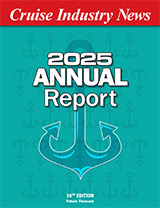At last week’s cruise conference in Miami, Martin Saarikangas, president of Kvaerner Shipbuilding and chairman and CEO of Kvaerner Masa-Yards, summed it all up when he said that his booming voice at least “had awakened the audience.”
Saarikangas, who was seated in the audience during the state of the industry debate, was responding to a question from the moderator about halfway through the session. At this time, despite assurances from the cruise line executives on the debating panel about a standing-room-only audience, half the attendees had already left.
The hottest topic was whether the cruise lines would guarantee to maintain a minimum 10 percent commission level for travel agents, which Bob Dickinson, president of Carnival Cruise Lines; Art Rodney, president of Disney Cruise Line (DCL); Peter McHugh, president and COO of Holland America Line (HAL); Hans Golteus, president and COO of Norwegian Cruise Line (NCL); and Peter Ratcliffe, president of Princess Cruises, said they would. However, Dickinson also underlined that Carnival may change its overall commission structure. He said that travel agents rebate too much and that if over-ride commissions were paid to agents only at the end of the year, agents may be less inclined “to give away money they don’t yet have.”
Jack Williams, president of Royal Caribbean International (RCI), and Rick Sasso, president of Celebrity Cruises, would not guarantee a 10 percent minimum level, but said that their commissions would be competitive. Golteus also noted that NCL pays full commission on the air portion of air/sea packages.
Yawn…
So what put the audience to sleep? Instead of a state of the industry opening, the first 15-plus minutes were a presentation of the Florida Caribbean Cruise Association.
For those who were still awake, Rick James, chairman of the Cruise Lines International Association and senior vice president of sales and corporate relations for Princess, provided a 20-minute status report on the industry. He was predictably upbeat and painted a rosy picture of the industry’s future.
Then it was the panel’s turn to comment. Dickinson set the tone with a 90-second comment, basically noting his agreement with James’ report. So did everybody else, but in more verbose terms.
With much of the audience lulled into sleep, Ratcliffe also proceeded to make a sales pitch for associate membership in the International Council of Cruise Lines (ICCL), which was as inappropriate as was the FCCA presentation.
As the panelists were commenting in alphabetical order, Williams was last. He noted that as RCI was in a “quiet period” due to certain stock offerings, he could not comment on the future. Instead, he went on to tell the audience about his first (and only?) cruise…
Thus this state of the industry debate was not up to the quality the audience had come to expect from the annual Miami cruise conference. Several attendees grumbled about the fee they had paid to listen to what in the end sounded like a three-hour industry commercial.
Points Made
Dickinson noted that despite the mild winter in the Northeast and Midwest, bookings were strong, which he said was a “good sign.”
Rod McLeod, executive vice president for Carnival Corporation, said that “all the things that are supposed to be down are down,” such as interest rates, unemployment, and the deficit, and that “all the things that are supposed to be up are up,” such as income and consumer confidence. Thus, he said, the economy is helping the industry.
The challenge, according to McLeod, is for the industry to manage its tremendous success.
Ratcliffe also noted how U.S. demographic trends are benefiting the cruise industry: what he called the aging of America, maturing baby boomers, and families seeking to spend quality time together. These trends combined with economic factors will help the industry grow, Ratcliffe said.
Global Growth
Golteus said that the industry was entering a new growth phase and forecast more global growth both in terms of passenger sourcing as well as deployment.
McLeod agreed that Europe has tremendous opportunity as a source market. Golteus added that the European Union countries have more people than the United States who have more vacation time and can afford to cruise. He said that the cruise lines must make investments in marketing in Europe and adapt their products.
But McHugh was more reserved on the European potential and said that European operators were better suited to satisfy European consumer demands. Dickinson also took a more reserved position and said that Europe was limited by seasonality and by cultural differences.
Ratcliffe added that there has been tremendous growth in the U.K. market which he expects will spill over into other European markets. However, he sees different products designed for different cultures. Still today, rather than sourcing in Europe, the Princess president said that there are more Americans going to Europe than ever, noting how the 2,600-passenger Grand Princess sold out her European summer season after three months.
As far as Asia is concerned, panel members saw mostly long-term opportunity. The only one to differ was Golteus who said it was not a question of “if’ but “when” NCL will go to the Far East. Golteus also referred to a previously announced joint venture through which NCL will base a ship in Australia.
Dickinson meanwhile said that Carnival is committed to the Caribbean and that the other lines that are looking to Europe and the Far East “maybe are getting out of Carnival’s way.”
Growing the Market
Rodney said that DCL is targeting the 75 percent of the U.S. population that has already visited Disney parks and not the 10 percent that has already cruised.
Thus, DCL will help the industry grow, according to Rodney.
Ratcliffe added that the cruise lines need to differentiate their brands in order to bolster growth. If all cruises look the same, price becomes the only sales factor, he said.
Shipbuilding, etc.
Ratcliffe also was not concerned with the traditional cruise-ship-building yards filling their orderbooks. “If there is a shortage of yards, other yards will come forward,” he said.
It was to this that Saarikangas commented (and woke up the audience) that cruise-ship building is not for newcomers.
But will the cruise lines consider building in the U.S.? Only Golteus said that NCL has looked at domestic yards and “has had discussions and will continue to talk.” Rodney said that DCL had initially talked to Newport News, but that the yard had not been able to meet the line’s time-frame. Williams said that RCI was watching American Classic Voyages (American Hawaii), which is soon expected to announce a domestic two-ship newbuilding order, “closely.”
Ship Deployment
During the ship deplo ent conference session speakers for Barcelona and Sydney went on about the glories of the Olympic Games.
When they were finished, a cruise line panel composed of Mike Ronan, director of port planning, RCI; John Drysdale, director of business development, Sun Cruises; and Chris Bailey, vice president of sales and marketing, the other Sun Cruises; commented that special events on the scale of the Olympic Games were not very practical for ship deployments. In fact, such events could be negative, they said, with hotel ships taking away berthing space, and athletes and spectactors commanding hotel rooms and airline seats. In addition, other problems include taking a ship out of its regular service and selling the repositioning voyages to and from the game location.
Noted
• Italian cruise ports joined together for a presentation of their facilities, including Civitavecchia, Genoa, Leghorn, Naples, Savona and Venice.
• The formation of Scottish cruise ports into a new group called Cruise Scotland was announced.
• John McNeece, naval architect, presented his new ship concept called the Cruise Bowl, designed for 12,000 passengers. The design is based on offering special events that will attract passengers. But he missed the boat. Instead of special events, McNeece should have designed a giant floating mall.
• The Caribbean role, or lack of such, at the cruise conference was also noteworthy. The region, which commands some 70 percent of all the cruises, was not represented on any of the panels during the conference sessions.
Bottom Line
So is the cruise conference worth taking part in? Of course it is. It is a great presentation of the industry, an opportunity to exhibit products and services, and a an opportunity to meet people. But the conference seminar sessions lacked the color and the substance they used to have.



